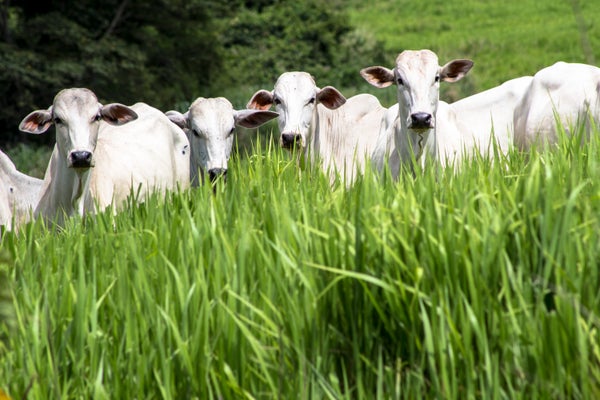This article was published in Scientific American’s former blog network and reflects the views of the author, not necessarily those of Scientific American
The story of cows and the environment may not be all bad news after all. The animals’ outsize impacts have become more prominent in environmental conversations lately and for good reason. Beef and dairy are responsible for more greenhouse gas emissions than any other food source by a long shot, largely because of methane from cattle’s digestion, emissions from manure, and the conversion of carbon-rich forest to pasture and cropland for animal feed.
While the development of meat and dairy substitutes, such as plant-based meat, is helping shift diets in rich countries, the world is still consuming more beef and milk every year. As emerging economies grow, we can expect their beef consumption to follow in lockstep. While this increase signals that more people are able to afford richer, more varied diets, it offers grim prospects for the climate. But there’s a positive story as well—one that is underappreciated and provides hope that livestock’s impact can be reduced: the story of peak pasture.
In the past 20 years, something remarkable has occurred, something few predicted: after several centuries of expansion, global pasture area has begun to shrink. According to the United Nations’ most recent data, there are a whopping 140 million fewer hectares of pasture than there were in 2000, an area roughly the size of Peru. Because pasture is one of the largest drivers of deforestation in many regions—and of the habitat loss and carbon emissions that follow—this is good news for the environment.
On supporting science journalism
If you're enjoying this article, consider supporting our award-winning journalism by subscribing. By purchasing a subscription you are helping to ensure the future of impactful stories about the discoveries and ideas shaping our world today.
Possibly the most surprising fact about peak pasture is how widespread it is. While pasture area has fallen most dramatically in Australia, it has contracted or stayed the same in roughly two thirds of all countries since 2000.
This positive trend has a strikingly simple explanation: rising productivity of pastureland and livestock. Thanks to modern breeding efforts and more resource-efficient practices, the world is producing a greater amount of meat and milk than ever before, even as pasture area has shrunk. Average global beef production per cow, for instance, has grown about 30 percent since 1961, and land managers across continents have begun growing specific grasses for cattle to eat that can boost production severalfold.
Analogous to the green revolution of the 20th century that brought unprecedented levels of crop productivity, it’s fair to say that the world has undergone a “livestock revolution”—not the whole world, however. Most notably, productivity remains low in sub-Saharan Africa, where widespread overgrazing degrades the quality of grazing land. Rapid population and economic growth in the region, in combination with persistently low productivity, could augur a major reexpansion of global pasture.
To a great extent, then, the future of global pasture—whether it continues contracting or expands once again—turns on whether the livestock revolution comes to sub-Saharan Africa. As it has elsewhere,elsewhere, such a revolution across the region will require growing more productive grasses and crops for cattle, improving breeding programs, and providing animals with proper shelter and veterinary care. Facilitating this transition will depend upon actions by governments to help producers overcome barriers to the adoption of new practices. As demonstrated in Brazil, for instance, governments can improve productivity by providing technical assistance and financial credit to producers.
Yet governments must also take measures to ensure that greater productivity doesn’t backfire and result in ranchers expanding their operations. Efforts that have been successful include closely monitoring forests and imposing fines for deforestation, extending financial credit when producers comply with environmental regulations and creating protected areas where agriculture is prohibited. Further, to be socially equitable, the transition toward intensification should respect the integral role of livestock in the lives, livelihoods and cultures of local communities while always striving to improve animal welfare.
We don't know where beef and dairy demand will go this century. While demand continues its seemingly inexorable rise, dietary changes and meat and milk alternatives could surprise us and bend the curve downward. But no matter what amount of cattle production we see this century, dramatically increasing productivity across much of the world is key to minimizing livestock’s footprint. Peak pasture shows that we can shrink that footprint even while meeting rising demand. The challenge for the coming decades is whether we will develop the government and private sector initiatives to continue this trend.
